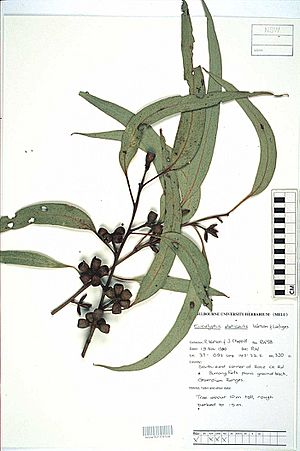Grampians grey-gum facts for kids
Quick facts for kids Grampians grey-gum |
|
|---|---|
 |
|
| A dried plant sample of the Grampians grey-gum. | |
| Scientific classification | |
| Genus: |
Eucalyptus
|
| Species: |
alaticaulis
|
| Synonyms | |
|
Eucalyptus cypellocarpa L.A.S.Johnson |
|
Eucalyptus alaticaulis, also known as the Grampians grey-gum, is a special type of tree or mallee. It only grows in a small part of the Grampians National Park in Australia. This tree has rough, stringy bark near its base. It has long, narrow leaves, white flowers, and fruit that looks like a small cylinder.
Contents
What Does the Grampians Grey-Gum Look Like?
The Grampians grey-gum can grow up to about 20 meters (66 feet) tall. It has rough, grey, stringy bark on the lower part of its trunk and main branches.
Leaves and Flowers
Young plants have leaves that are wide and shaped like an egg. They are about 140 mm (5.5 inches) long and 90 mm (3.5 inches) wide. These young leaves are shiny green on top and lighter underneath.
Adult leaves are long and narrow, like a spear. They can be 120 to 300 mm (4.7 to 11.8 inches) long and 20 to 45 mm (0.8 to 1.8 inches) wide. These leaves have the same color on both sides.
The tree's flower buds grow in groups of seven. They are shaped like a cylinder and have a cone-shaped cap. The flowers themselves are white.
Fruit
After the flowers, the tree produces fruit. The fruit is shaped like a cylinder or an oval. It is about 10 mm (0.4 inches) long and 9 mm (0.35 inches) wide.
This tree used to be thought of as part of another species, E. cypellocarpa. However, the Grampians grey-gum is shorter, keeps its bark longer, and has wider young leaves.
Where Does the Grampians Grey-Gum Live?
The Grampians grey-gum is found only in the Grampian Ranges. It grows on dry, rocky slopes in this area.
Naming the Grampians Grey-Gum
The scientific name Eucalyptus alaticaulis was first officially described in 1987. This was done by scientists R.J.Watson and Pauline Y. Ladiges. They published their description in a science journal called Brunonia.
The name alaticaulis comes from two Latin words. Alatus means "winged," and caulis means "stem" or "stalk."

